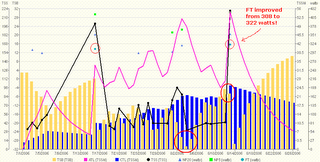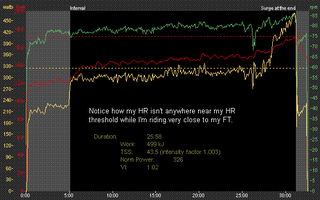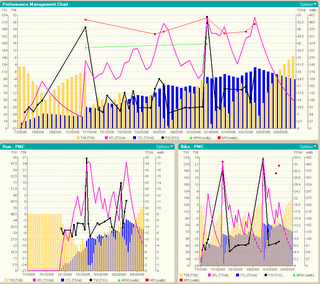Well, I'm once again on the training bandwagon and this time I thought that I might share what it is I'm doing. I don't have any goal races yet as I'm simply looking to return to some level of fitness first. It was a rough winter and spring for me as I had to battle some illness brought on by having a very worn down immune system.
This time around, however, I have a new secret weapon. The upcoming release of WKO+ contains a new feature called the "Performance Management Chart". There are lots of forthcoming articles and details surrounding the exact function of this and I'll leave it for the experts to profess the details. But, the general idea is that it is a tool for managing your long term (chronic) and short term (acute) training loads. The difference between the two is referred to as the "Training Stress Balance (TSB)".
The idea is simple. As you increase your training loads, the ATL exceeds the CTL and creates a deficit in the TSB. That simply means that you're not going to be setting any new records for the time being. But, as the race gets closer, you reduce the training loads so that your ATL is below your CTL and thus the TSB begins to rise (duh, you're tapering).
To the right is my present Performance Management Chart. I've highlighted a few items of interest.

First, I'm glad to report that my Functional Threshold has officially risen 4.5% in the past month! Woo hoo! You can see the values (circled) and plotted on the PMC.
The blue bars indicate that my training volume has been growing. So, it's no surprise that my FT is rising. What's even more encouraging, however, is the fact that my TSB from this morning was still well below zero. Whereas, last month, it was zero and rising (meaning that I really had full potential to perform well).
The PMC has more usefulness than simply predicting the potential of race day performance levels. Of significant interest to me is establishing levels of fatigue that are compatible with the rest of my life. Through a little trial and error, I've decided that a TSB of -30 is about the most fatigue that I'm willing to put up with right now. Using the PMC, it becomes very easy to determine whether or not to do that extra workout or even cut something short.
So, rightly or wrongly, at the moment, I'm using the PMC as a guide to drive my TSB down to -30 and then slowly recovering my way back to something closer to (but still below) zero. My underlying goal is to achieve a chronic training load of 50 TSS/day. That is the equivalent of roughly 30 minutes of activity at threshold every single day. Once I reach that goal, I'll decide on what to do next.
Now, there is a small caveat to this if you do more than cycle. TSS is the primary input into the system and if you train with a power meter, you may already be familiar with this metric. But, like most triathletes, I also swim, run and lift weights. We've added the ability to over-ride (or manually input, if you will) a TSS value for any workout in WKO+! Unfortunately, we do not yet calculate a TSS for sports other than cycling. For those wondering, I simply established my own scoring system based upon heart rate. It's primitive and subject to lots of interference, but it works very well for my needs right now. You are free to construct your own methods for the time being.

 This time, I set out to ride 1' in increasingly harder gears while maintaining a steady cadence and then returning to my starting level. Repeat again using a slightly quicker cadence. and so forth. (The abrupt end was due to reaching my goal TSS for the workout).
This time, I set out to ride 1' in increasingly harder gears while maintaining a steady cadence and then returning to my starting level. Repeat again using a slightly quicker cadence. and so forth. (The abrupt end was due to reaching my goal TSS for the workout).



